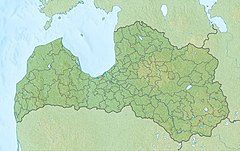You can help expand this article with text translated from the corresponding article in Latvian. (December 2009)Click [show] for important translation instructions.
|
| Ogre | |
|---|---|
 Ogre river in Ogre city. | |
 | |
| Location | |
| Country | Latvia |
| Physical characteristics | |
| Source | |
| • location | Sivēniņš lake in Liezēre parish |
| • elevation | 222 m (728 ft) |
| Mouth | Daugava |
• location | Ogre |
• coordinates | 56°48′39″N24°36′06″E / 56.8108°N 24.6017°E |
| Length | 188 km (117 mi) |
| Basin size | 1,730 km2 (670 sq mi) |
| Basin features | |
| Progression | Daugava→ Baltic Sea |
| Tributaries | |
| • left | Lobe |
| • right | Līčupe, Ranka |
The Ogre is a river in Latvia. The 188 kilometers long Ogre is a right tributary of the river Daugava. In the 13th century, the Ogre was called Wogen or Woga.
